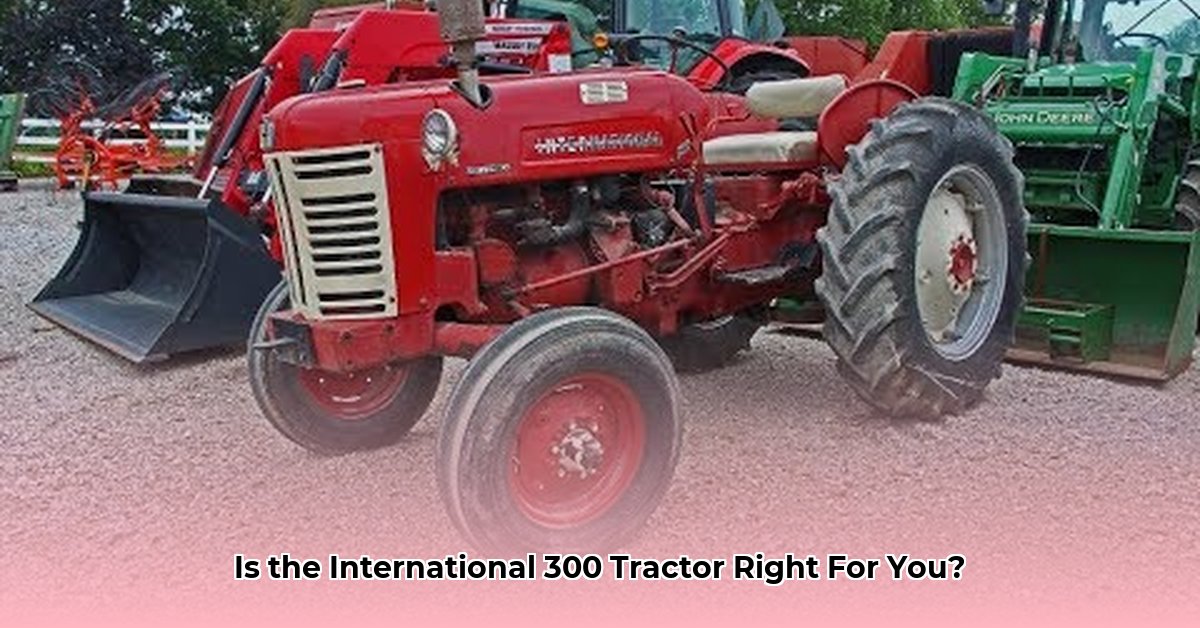
Thinking about adding a classic International Harvester 300 tractor to your collection or farm? These robust machines are highly sought after, but navigating the purchase, restoration, and valuation process requires careful planning. This guide provides actionable steps to help you succeed. For more in-depth information, check out this helpful resource: IH 300 information.
Diving into the International Utility 300 Tractor Market
The IH 300, manufactured between 1955 and 1956, boasts impressive production numbers—around 60,000 units. This abundance increases your chances of finding one, yet also contributes to a wide price range. What drives this variation? Several key factors significantly influence the value: condition, operating hours, included features, and even geographical location.
What Affects the Price of an IH 300?
Several factors determine the value of a used IH 300 tractor. Condition is paramount; a meticulously maintained tractor with low operating hours commands a higher price compared to a neglected machine requiring extensive repairs. Additional features such as a two-speed power shift or an independent PTO (Power Take-Off – a mechanism for powering other equipment) significantly increase value. Specific variations within the Farmall 300 line can also affect pricing. Finally, remember that market demand fluctuates, influencing price trends.
Your Step-by-Step Guide to Buying an IH 300
1. Thorough Research: Before beginning your search, explore online auction sites and classifieds to understand current market prices for comparable models. This groundwork helps establish a realistic budget and expectations.
2. Pre-Purchase Inspection: A Critical Step: A comprehensive pre-purchase inspection is crucial. Look for rust, signs of mechanical issues, and general wear and tear. Check all fluids and thoroughly test every system. If you're uncertain about any aspect, consult a qualified mechanic.
3. Strategic Negotiation: Armed with your research and inspection findings, negotiate a fair price. Remember that sellers also incur costs, and compromises are necessary for a successful transaction.
4. Due Diligence: Verifying Ownership and History: Before finalizing the purchase, verify ownership using official documentation. Review service records, maintenance logs, and any available documentation. A clear history reassures you of the tractor's past care.
5. Secure the Transaction: Once satisfied, finalize the purchase with a legally sound sales agreement, ensuring clear terms and conditions are established.
Restoring and Maintaining Your IH 300: A Rewarding Process
Owning a classic tractor requires regular maintenance and occasional repairs. Develop a comprehensive restoration budget, identifying necessary repairs and sourcing parts. While many parts are readily available from specialized suppliers, some may require more time and effort to locate. Engage with online forums and communities to seek advice and connect with fellow IH 300 enthusiasts. Their expertise and shared experiences are invaluable.
Assessing the Value of Your Restored IH 300
After restoration, your IH 300's value is likely to increase. However, several factors influence the precise market value. Condition, restored features, and current market demand all play a role. Consult online resources, compare prices of similar tractors, and consider that regional markets may affect value.
Potential Pitfalls and Mitigation Strategies
The table below highlights potential problems and strategies to help avoid them:
| Risk Factor | Potential Severity | Mitigation Strategy |
|---|---|---|
| Hidden Mechanical Problems | High | Thorough pre-purchase inspection by a qualified mechanic; budget for unexpected repairs. |
| Difficulty Sourcing Parts | Moderate | Research reputable parts suppliers in advance; explore alternative parts or rebuild options; engage with online forums. |
| Market Price Fluctuations | Moderate | Regularly monitor market trends; understand that prices are subject to change. |
| Unexpected Restoration Costs | High | Develop a detailed, realistic budget; prioritize and phase essential repairs; include a contingency for unforeseen issues. |
How to Determine the Fair Market Value of a 1955 International Harvester 300 Tractor
Accurately determining the fair market value requires diligent research and a systematic approach.
Market Research: A Foundation for Valuation
Conduct thorough market research to establish a baseline for your valuation:
Online Auction and Sales Sites: Analyze recently sold listings on platforms like eBay and specialized agricultural equipment sites. Note the condition, included features, and final sale prices of comparable 1955 IH 300 tractors.
Collector Forums and Clubs: Engage with online communities of IH 300 enthusiasts. Their collective knowledge and experience provide valuable insights into recent sales, typical prices, and potential issues.
Condition: The Most Significant Factor
The tractor's condition is the most significant value determinant:
Mechanical Functionality: Assess the engine's performance, transmission operation, and overall mechanical integrity. A fully functional tractor commands a higher price.
Cosmetic Condition: Evaluate the tractor's appearance, including rust, paint quality, and overall wear. Minor imperfections are less impactful than significant damage.
Completeness: A complete tractor with all its original parts, especially rare accessories, is more valuable.
Documentation: Supporting Your Valuation
Comprehensive documentation strengthens your valuation:
Detailed Photographs: Provide high-quality photographs demonstrating the tractor's condition, including both strengths and weaknesses.
Thorough Description: Document the tractor's history, mechanical status, any repairs or restorations, and unique features.
Service Records: If available, service records offer valuable evidence of past maintenance and upkeep.
Your Personal Valuation Strategy: A Step-by-Step Approach
Compile Data: Gather data on recently sold IH 300 tractors from your market research.
Compare and Contrast: Analyze the collected data, noting variations in condition, features, and location.
Adjust Based on Condition: Carefully assess your specific tractor's condition and adjust your initial valuation accordingly.
Expert Consultation (Optional): For rare or exceptionally well-preserved models, consult a professional appraiser for an expert opinion.
Additional Tips for Accurate Valuation
Regional Price Variations: Be aware that prices can vary significantly across regions due to supply and demand.
Rarity: Specific features, original paint schemes, or particularly well-preserved models can command higher prices.
Key Takeaways: Auction results provide the most reliable data for valuation; condition significantly impacts value; regional pricing variations exist; thorough documentation is crucial. For specialized cases, consult a professional appraiser.